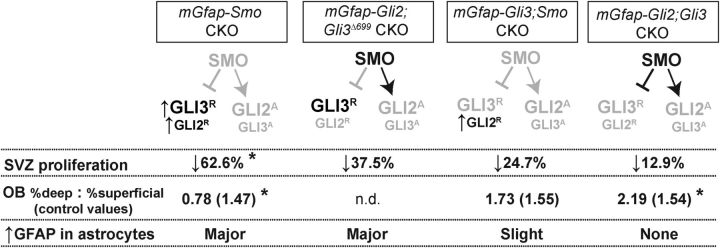Figure 10.
SVZ proliferation, OB interneuron specification, and astrocyte morphology require precise titration of GLIR levels by SHH. Summary of the three distinct SHH-dependent phenotypes observed in mouse mutants lacking Smo and/or Gli2 and Gli3 or expressing GLI3R (Gli3Δ699) in GFAP-expressing cells in the postnatal forebrain. Phenotypic changes that are statistically significant based on analyzing 3–4 animals are indicated by an asterisk. The GLI proteins that remain in the mutants are indicated above the phenotypes, demonstrating the degree to which regulation of the correct dose of GLI3R and GLI2R is necessary for each developmental process, and the very limited role of GLIA. Mice lacking Gli2 or Gli3 alone have no obvious defects in the adult forebrain (not indicated). In mice lacking only Smo, no GLI2A or GLI3A is produced and instead the levels of GLI3R and GLI2R are increased. This results in a loss of slow-cycling NSCs in the SVZ, which leads to a major decease in the percentage of proliferating cells in the SVZ (SVZ proliferation), a decrease in the number of newly born OB neurons (not indicated), an alteration in the proportion of deep versus superficial OB interneurons produced (OB %deep : %superficial; control percentage shown in brackets), and an increase in the number of GFAP-expressing astrocytes and morphological changes indicating partial gliosis (↑GFAP in astrocytes). SVZ neurogenesis is decreased to a lesser extent in mice lacking Gli2 and only expressing a low level of a GLI3R (mGfap-Gli2;Gli3Δ699 CKO), whereas the defect in astrocyte function is similar to that in mGfap-Smo CKOs. In mice lacking Smo and Gli3, and in which only GLI2R is expressed (mGfap-Smo;Gli3 CKO), there is only a mild reduction in neurogenesis, a slight increase in astrocyte gliosis, and OB interneuron production and the proportion of deep and superficial neurons is restored to normal levels. In contrast, in mice lacking Gli2 and Gli3 that produce no GLI 2/3A or GLI2/3R proteins (mGfap-Gli2;Gli3 CKO), neurogenesis is almost normal and astrocyte function appears normal, but the ratio of deep/superficial OB interneurons is changed in the opposite direction to that in Smo mutants.

